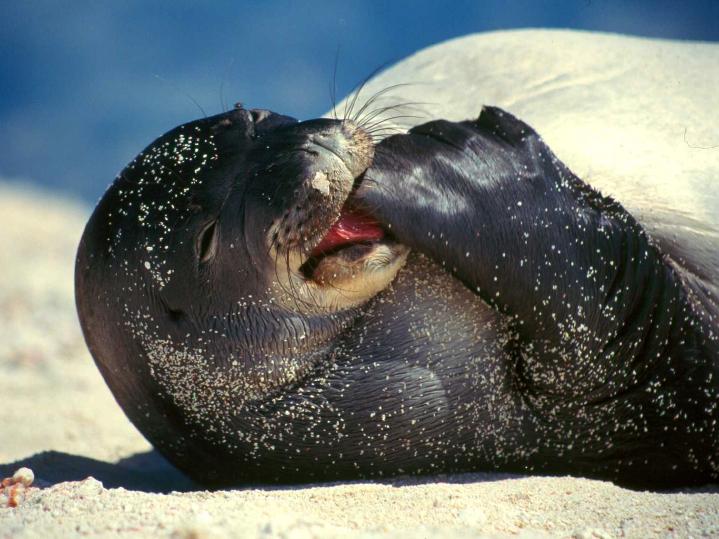Blog
News, updates, finds, stories, and tidbits from staff and community members at KAHEA. Got something to share? Email us at: kahea-alliance@hawaii.rr.com.
Monk Seals: Critcal habitat, Critical discussion
In the last few weeks, we’ve received letters of strong support and strong opposition to the proposed rule on critical habitat for the Hawaiian monk seal. We hope this blog will open up some safe space for discussion.
No Public Speaking Allowed?
We attended the Honolulu scoping meeting on the Navy’s planned expansion of sonar and underwater munitions testing and training activities two weeks ago. We’re still working on processing the information and our thoughts about the process. In the meantime, we thought we’d share these thoughts from Uncle Jim on Moku o Keawe about their experience in Hilo:
From Uncle Jim Albertini:
Tonight’s (8/26/10) EIS Scoping Meeting on Navy expansion plans for Hawaii and the Pacific was more hardball than the Marines similar meeting of 2 days ago. (Then again, at the Marines meeting we had retired Marine Sergeant Major, Kupuna Sam Kaleleiki, to open the path with a pule and the initial public testimony.)
The Navy EIS personnel weren’t nearly as respectful of the right to public speaking and the community being able to hear each others concerns. Some of the Navy team were downright arrogant, insulting and contemptuous. Initially the Navy wasn’t going to allow us to bring our portable sound system into the Hilo H.S. cafeteria to hold a citizen public hearing. Finally with police presence brought in, the Navy yielded the last hour of the planned 4-8PM event to our citizen hearing.
Some of the Navy EIS team were blatantly rude in not listening to community speakers and carried on their own conversations. Before the public testimony, we invited all present to join hands in a pule and asked for mutual respect, and open minds and hearts.
The Navy refused to have any of their personnel take notes to make the public comments part of the official record of scoping concerns. Community people were very respectful of the Navy personnel as human beings, but the aloha spirit wasn’t returned by many of the Navy people present. Too bad.
Many of the Navy people were hard set to their format. Tour the science fair stations, and If you wanted to comment, put it in writing or type it into a computer. We were told over and over. This is not a public hearing. No public speaking is allowed.
Reading: Environment Hawai'i, August Issue
We got our August issue of the excellent Environment Hawai’i in the mail the other day!
On DAR’s proposed list of activities that they believe should be exempted from doing environmental assessment, they write, “DAR’s proposed list appears to exempt every type of permit and license issued by the division.” Including live rock and coral collecting permits and all permits for Papahanaumokuakea in the Northwestern Hawaiian Islands.
There is also great coverage of Waimanalo Gulch violations and wet-noodle enforcement from the Department of Health, and excellent reporting on this summer’s WESPAC meetings.
Mahalo to Pat and Teresa for their excellent investigative reporting! You can support Environment Hawai’i by subscribing today!
Laughable public process: changes to conservation protections
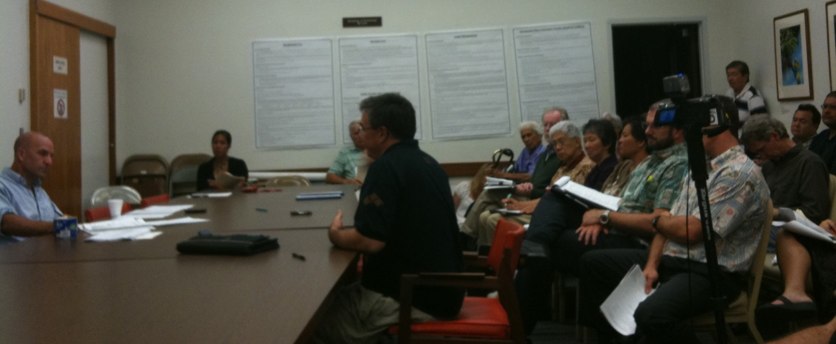
Hearings officer Sam Lemmo, the administrator for OCCL, made a point of assuring the room that the final regulations would definitely be different from what we are seeing tonight based on all of the great input they had been getting. (Did you just feel that gentle pat on the top of your head? I did.)
We pressed Sam on when we might actually see the final regulations. Generally speaking, the agenda for the Board of Land and Natural Resources is posted a mere six-days before the Board decides an issue. Will we only get six days to review the final version of the rules that are supposed to be protecting our conservation lands for at least the next 15 years?
In response, Sam chuckled and said “good question.” The audience laughed. I laughed, too — because what do you do when someone laughs in your face? Despite all the laughter it was a sad moment.
It is sad when regulations as important as these are given but the bare minimum of study and public process. We are talking about 2 million acres of conservation lands — our watersheds, nearshore waters… the important places. Conservation lands are 51% of the crown and government lands that are supposed to be held in the “ceded” lands trust for Native Hawaiians and the people of Hawaii — we have an obligation to protect these assets.
From what I hear from the old-timers, when these rules were changed 15 years ago, there was a public blue ribbon panel convened to advise the division on improving the regulations. Today, DLNR is unilaterally proposing major revisions. What gives? Where is the expert panel? The thoughtful study? The reasoned assessment?
In response to my quote on the need for “a blue ribbon panel” in the Star-Advertiser on Thursday, several insiders came forward at the hearing to thank Sam for DLNR’s history of work on these rule changes that were, in their words, “a long-time coming.” So long in coming, in fact, that the public just heard about them. These rules saw the first light of day in July and are expected to be approved before December. Coincidentally, that’s right before the Lingle Administration leaves office. Feels more like a 50-yard dash than a “long-time coming” to me.
Both in and out of public hearings, we have heard Sam say, at least 20 times (no exaggeration, I seriously counted), “Good question, that wasn’t what I intended” in response to questions and concerns about the staff’s proposed changes. I don’t know about you guys, but if what I write down isn’t what I meant to say, its usually because I was in a rush and didn’t take the time to think about the implications… welll… that kind of pondering is exactly what we need right now.
Good changes, bad changes, the bottom line is these changes need more thought. We should not let the timeline for the end of an administration drive the schedule for amending some of the most important protections in our islands.
Want to feel like you were there? Here is a link to notes from the Honolulu public hearing on August 12, 2010.
Want to participate in the process? Sign up for KAHEA’s action alert network, later this week we’ll send out an easy-to-use comment form by email.
That Deafness? It's Only Temporary.
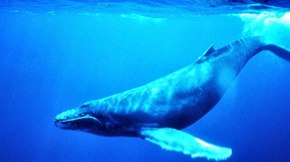
Many of you followed the sonar lawsuit from 2008, in which KAHEA, in partnership with Earthjustice and other local, national and international NGOs, sued the U.S. Navy over its proposed expansion of military exercises around Hawai’i, including the Northwestern Hawaiian Islands. The State of Hawai’i, at our urging, also asked the Navy to comply with laws protecting endangered species in Hawai’i. Not surprising, the Navy refused.
Now, there’s another round of public scoping hearings for more sonar and more detonations. But don’t worry about those whales. According to the U.S. Navy, the deafness caused by underwater explosions and sonar is only temporary.
An update on U.S. Navy training in Hawaiian waters, from the Hawaii Independent:
The U.S. Navy announced its intent to prepare an Environmental Impact Statement (EIS) and Overseas EIS (OEIS) relating to military training and research, including sonar and detonating explosives, within the Hawaii-Southern California Training and Testing (HSTT) study area.
Public scoping meetings throughout Hawaii have been scheduled to hear comments. Last year, the federal government issued authorization to the U.S. Navy to impact whales and dolphins while conducting sonar training exercises around the main Hawaiian Islands for five years, Environmental News reported.
The letter of authorization and accompanying rules allow for injury or death of up to 10 animals of each of 11 species over the five years covered by the regulations. The Navy requested authorization under the Marine Mammal Protection Act because the mid-frequency sound generated by tactical active sonar, and the sound and pressure generated by detonating explosives, may affect the behavior of some marine mammals or cause what the Navy calls “a temporary loss of their hearing.”
Mid-frequency sonar can emit continuous sound well above 235 decibels, an intensity roughly comparable to a rocket at blastoff, according to Environmental News.
The sonar blasts travel across hundreds of miles of ocean to reveal objects, such as submarines, underwater. The National Marine Fisheries Service (NMFS) will be a cooperating agency in preparation of this EIS and OEIS. In January 2009, the NMFS’s ruling stated: “After reviewing the current status of the endangered blue whale, fin whale, humpback whale, sei whale, sperm whale, Hawaiian monk seal, green sea turtle, leatherback sea turtle, loggerhead sea turtle, and Pacific ridley sea turtle, … [Navy training activity in the Hawaii Range Complex] each year for a five-year period beginning in January, 2009, are likely to adversely affect but are not likely to jeopardize the continued existence of these threatened and endangered species under NMFS’s jurisdiction.”
While Earth Justice wants the Navy to stop using sonar until it can avoid serious injury to marine mammals, the environmental group recommends several things the Navy can do to minimize the harm to marine life: Impose seasonal and geographical limitations, avoid nursing areas, ramp sonar up slowly, avoid areas that were created specifically to protect endangered marine life, create a 25-mile safe haven distance from shorelines, avoid steep-sloping seamounts that provide important habitat for many marine species, prohibit testing at night or other times of low visibility, and adopt protocols similar to those of other naval forces to minimize the impact on marine wildlife.
The Navy’s latest proposed action is to conduct training and testing activities within the at-sea portions of existing Navy training range complexes around the Hawaiian Islands and off the coast of Southern California. Training activities, such as sonar maintenance, explosives, and gunnery exercises, may occur outside of Navy operating and warning areas. In 2009, the Navy instituted mitigation measures relating to sonar that include stationing lookouts, adjusting sonar decibel levels when marine animals are detected within 200 to 1,000 yards, and increased visual and aerial surveillance for marine life. The HSTT study area combines the at-sea portions of the following range complexes: Hawaii Range Complex, Southern California Range Complex, and Silver Strand Training Complex. The existing western boundary of the Hawaii Range Complex is being expanded 60 miles to the west to the International Dateline.
The HSTT study area also includes the transit route between Hawaii and Southern California as well as Navy and commercial piers at Pearl Harbor and in San Diego, CA where sonar may also be tested.
Public scoping meetings will be held between 4:00 p.m. and 8:00 p.m.
- Tuesday, August 24, 2010, Kauai Community College Cafeteria, 3-1901 Kaumualii Highway, Lihue, HI.
- Wednesday, August 25, 2010, Disabled American Veterans Hall, Weinberg Hall, 2685 North Nimitz Highway, Honolulu, HI.
- Thursday, August 26, 2010, Hilo High School Cafeteria, 556 Waianuenue Avenue, Hilo, HI. 6. Friday, August 27, 2010
- Maui Waena Intermediate School Cafeteria, 795 Onehee Avenue, Kahului, HI.
The meetings will consist of an informal, open house session with informational stations staffed by Navy representatives. Additional information concerning meeting times is available on the EIS and OEIS website at http://www.HawaiiSOCALEIS.com. The scoping process will be used to identify community concerns and local issues to be addressed in the EIS and OEIS. All comments provided orally or in writing at the scoping meetings, will receive the same consideration during EIS and OEIS preparation. Written comments must be postmarked no later than September 14 and should be mailed to: Naval Facilities Engineering Command, Southwest, 2730 McKean Street, Building 291, San Diego, CA 92136-5198, Attention: Mr. Kent Randall—HSTT EIS/OEIS.
Exemptions Gone Wild
Generally, under today’s environmental laws, certain kinds of projects have to do an environmental review (Like an EIS). Other kinds of projects can be exempted. The BP oil spill at Deepwater Horizon has been a sobering reminder of why these kinds of environmental reviews and exemptions are so critical. (Can you believe THIS was exempted from EIS?)
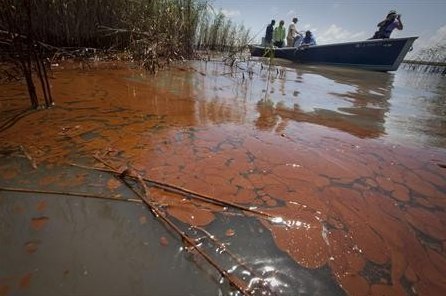
Today, DLNR is proposing a “wild laundry list” of EIS exemptions for DLNR-managed lands, from building new roads to chemical herbicides. That’s 57 pages (fifty-seven!) of exemptions. Yeesh. We are asking the Office of Environmental Quality and Control (OEQC) to send DLNR back to the drawing board. If you or your organization is interested in participating in a group letter to OEQC or just want to know more about this issue, please contact Marti at marti@kahea.org by Friday morning.
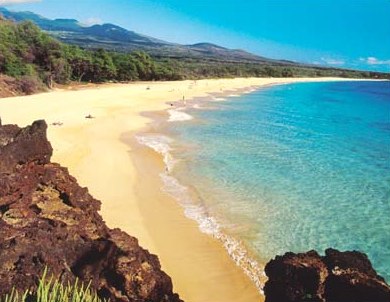
Pushing for the protections monk seals (and humans) need
Like a glove across the face, KAHEA and the Center for Biological Diversity sent a Notice of Intent to Sue yesterday warning federal regulators to expedite the critical habitat designation for Hawaiian monk seals… or else. Critical habitat is the backbone of the Endangered Species Act. It is the mechanism for shepherding species back from the verge of extinction. Over two years ago, we petitioned the National Marine Fisheries Service to expand the critical habitat designation for the highly endangered Hawaiian monk seal. And NMFS agreed the seal needed more habitat to thrive. Yet, more than a year since they agreed with us, NMFS is not any closer to protecting vitally important nearshore areas and deepwater foraging grounds for the seal.
Not surprising, in that year, Hawaiian monk seals have only slipped closer to extinction with a 4% annual decline. In 2009, monk seals had the lowest pupping rate in the past 10 years, with every location in the Northwestern Hawaiian Islands experiencing declines. In 2009, only 119 seal pups were born in the Northwestern Hawaiian Islands, compared with 138 in 2008. But in the Main Hawaiian Islands, birth rates seem more promising with 15 monk seal pups born including six pups on Moloka’i, five on Kaua’i, and two each on O’ahu and Maui. The federal government must act now to update the current protections for Hawaiian monk seals to ensure deepwater foraging areas of the NWHI are protected, as well as the areas being re-populated in the main islands.
Protecting this habitat for monk seals will also protect these areas for humans, too. Subsistence fishers and monk seals benefit from the same protections — where monk seals are protected, shoreline and nearshore non-commercial fishers are also protected. By expanding critical habitat for monk seals, we can ensure subsistence fishing grounds are not built over by hotels, highways, and industrial fish farms.

